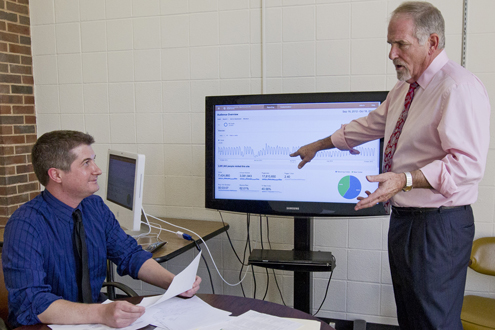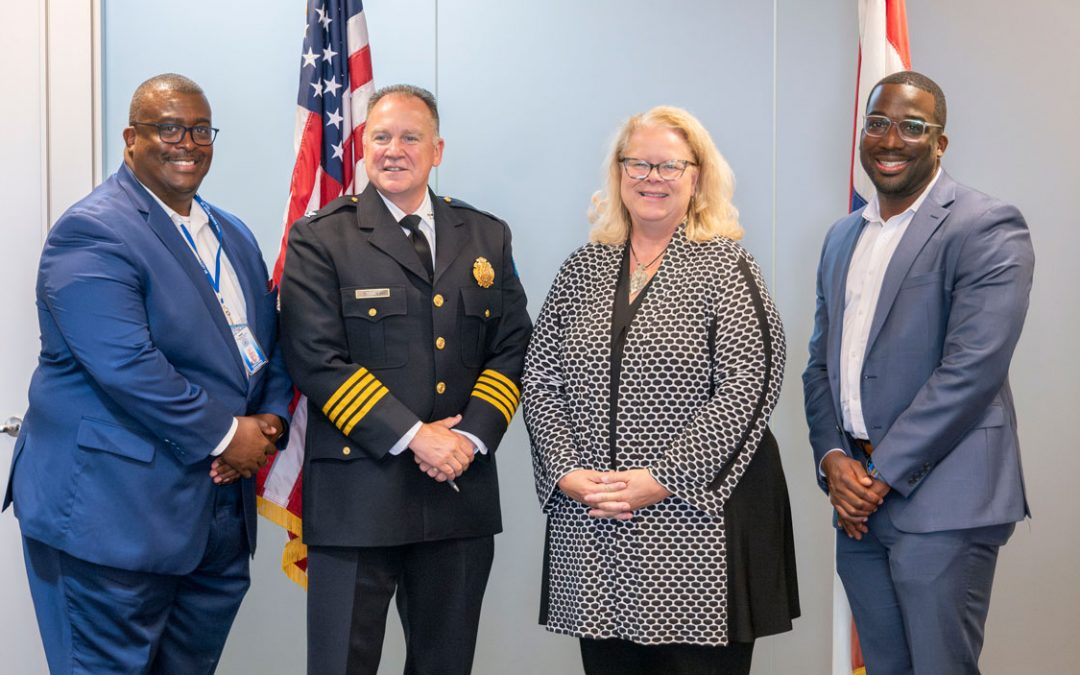
Ron Gossen (right), senior associate vice chancellor for university marketing and communications at UMSL, and Jon Hinderliter, assistant director of university marketing and communications, pore over web analytics during a recent meeting. They authored the CURRENTS article “Bursting the branded search bubble.” (Photo by August Jennewein)
In early 2011, marketers at the University of Missouri–St. Louis recognized that advertising on Google and other search engines was becoming more and more important as an advertising vehicle to reach “inquiring” potential students. It was at that time they added “search engine marketing” to UMSL’s traditional media advertising plan (billboards, radio, print) to promote the university’s UMSL Day open house in March.
“Surprising – no, shocking – to us, our paid search ads using the branded keywords ‘UMSL Day,’ accounted for 75 percent of UMSL Day registrations,” said UMSL’s Chief Marketing Officer Ron Gossen and Jon Hinderliter, assistant director of marketing and communications, who wrote about their experience for a highly regarded just-published higher education magazine.
The article, “Bursting the branded search bubble,” can be found in the October 2013 issue of CURRENTS, the monthly magazine of the Council for Advancement and Support of Education.
In the article, the UMSL marketers recalled a digital marketing “journey of discovery,” one whose research-validated premise shakes the foundations of a multi-billion dollar industry built around the business of paid search engine marketing.
“We looked at the addition of paid search engine brand advertising as another advertising vehicle, much like billboards, newspapers or radio,” the authors said. “Industry standards had even been developed to show the return-on-investment for ‘search marketing.’ What we found was much to the contrary. For us, branded search engine marketing wasn’t a new marketing channel. It was merely an easy way for prospects who were already motivated by other advertising media to find more information or to register for UMSL Day. It wasn’t a marketing channel, it was an information utility. Prospective students would see or hear our UMSL Day ads. Not paying attention to our web address, they would simply Google ‘UMSL Day,’ and then click on our paid ad.”
Over the next several campaigns, their data convinced them that “buying branded keywords was a waste of our marketing budget.” Considering that an entire industry was built around paid search advertising, the UMSL Marketers were flying solo in the face of convention until giant retailer eBay published their own research. In March, 2013, the UMSL authors’ empirical findings were supported by a massive eBay study, “Consumer Heterogeneity and Paid Search Effectiveness: A Large Scale Field Experiment.”
The authors caution that paid search advertising should not be written off entirely. They note the use of non-branded keyword phrases such as “nursing school” or “criminal justice degree” play an important role in marketing UMSL’s degree programs and campus tours.
“In each, we found that programs touted with strong unique selling propositions performed better than our competitors’ degree programs. For us, it was the creativity put behind the search marketing that paid rewards.”














